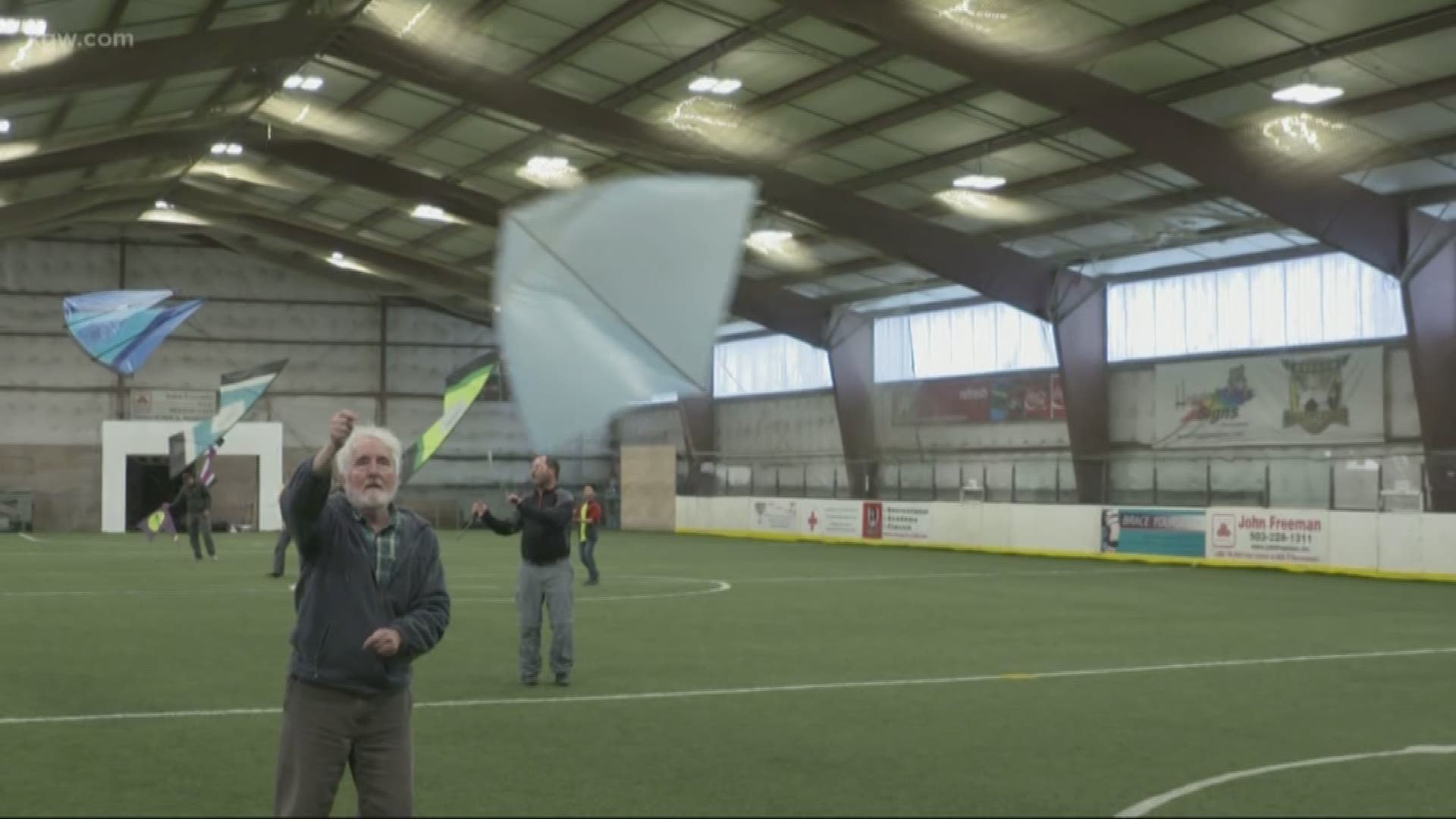CLACKAMAS, Ore. — When the winter weather turns wicked, step indoors at the Oregon Soccer Center in Clackamas, Oregon and discover serenity and soul-satisfying rewards flying a kite!
A Kite? Indoors? Oh yes, it’s been a terrific source of exercise and soothing therapy for kids and adults alike the past four decades. And there’s more – it turns out that Oregon is home to some of the finest kite flying talent in the world.
Many Oregon flyers travel the Pacific Northwest to perform and some are even world travelers!
“Kites can be flown indoors,” insisted Brett Morris, Director of the Western Region of the American Kitefliers Association. I visited with Morris at the Soccer Center – the weekly gathering place for local indoor flyers.
In fact, indoor kite flying and competition are becoming more and more popular all the time. “With performers appearing on shows like America’s Got Talent,” said Morris. “Indoor kites are designed to fly in a windless environment, it’s a type of kite principally designed for indoor use, but can also be flown outdoors when light wind would make traditional kite flying impossible.”
Indoor kites are flown by using the relative wind provided by the motion of the kite flier, pulling the sail against the still air in a room. The fliers create their own lift by slowly walking backwards, walking in large circles and occasionally pulling on the line.
“It takes practice,” according to longtime flier, Wayne Dowler. “But the indoor kite can be flown through all angles around the flier, including directly overhead on a single line!”
It's a relatively short-line form of flying that demands a certain level of finesse. The best fliers make it look easy, but of course it isn't. It is addicting to some, funny looking to others, but I suspect it's reasonably cool for most kite-fliers.
Many folks, like Morris and Dowler, said that they come to indoor kite flights for the exercise. “You’re out here moving and sweating – you’re exercising and getting your daily run – for me, it’s that and increased confidence too,” said Dowler.
The kites are so sensitive to air movements that they can actually be affected by someone else walking around nearby, and for experienced fliers like U.S. National Champion, John Barresi, the overall effect is graceful and artistic.
I watched wide-eyed as Barresi’s graceful movements included flying his quad kite (four different lines that control flight while he provides the lift) while lying down on the floor – and – as he made the kite jump and scoot and zoom just inches above the floor.
He was a pro in action and made the sport look easy and beautiful! “When people fly, they’re showing the better part of themselves,” said Barresi. “Your chin is up, you’re looking up and your heart is open and you’re playing with this tension in the line. Your mind goes calm. You don’t have to change your religion or your diet or anything to be a great kite flyer.”
Morris pointed out the number of youngsters that were also flying their own kites and noted, “They can make or buy them, but one thing is for sure, they love the exercise and challenge of keeping their very own kites – up – in the air – and doing tricks too.”
He added that the sport or recreation (which is it?) takes all of us back to our own childhoods when we built newspaper or garbage bag kites and learned to fly them. It’s so rewarding to see a youngster fly something they had a hand in building.”
Kites are also used for therapy, according to Paul Burks. He is a firefighter with the Hoodland Fire Department near Mt Hood and in 2013, he suffered what he called a “super concussion.”
A firehose with a brass fitting hit him on the head and he said the result was devastating. ”I went from being firefighter and honor guard commander and flying outdoor kites to the point that I couldn’t even walk. An accident like mine steals your entire life away.”
Indeed, the accident turned Burk’s physical and emotional well-being upside down, but he insisted that learning to fly a small plastic kite made a huge difference to his recovery.
“The nice thing is that these kites move slow enough that if you’re having overload problems like me - sensory overload - you can keep up with this small kite. Post-traumatic stress disorders, balance problems, brain injuries, limb loss, stroke – even folks in wheelchairs, I’ve worked with them all during my own recovery. I have watched people successfully fly kites and gain confidence and see the return of their motor skills. Kites are magical!”
Folks of all ages can learn how it’s done through the AKA and join in the fun each week at the Oregon Soccer Center. So, consider going indoors the next time someone tells you, “Go Fly A Kite!” You can contact Phil Burks for more information and arrange a visit: Pbgonefishing@yahoo.com or 503-348-6510.
If you would like to visit more of Oregon – consider a walk on the wild side with my latest book: “Grant’s Getaways: Oregon Adventures with the Kids.” You’ll find activities to engage any kid, from archery to clamming on the coast to hunting for thundereggs to zip-lining through trees in an aerial adventure park.
In addition, be sure to check out “Grant’s Getaways Guide to Wildlife Watching in Oregon.” you will enjoy 48 uniquely oregon adventures highlighting my fish and wildlife encounters. scores of colorful photos by “grant’s getaways” photographer, Jeff Kastner, show off some of our finest moments in the field. you can also learn more about many of my favorite Oregon adventures in: "Grant's Getaways: 101 Oregon Adventures."

